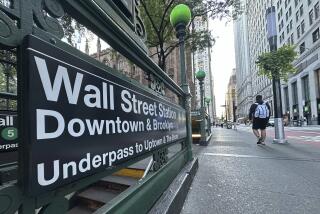Stocks lifted by Europe debt deal, U.S. economic data
- Share via
Reporting from New York — U.S. stocks are on track to post their biggest monthly gains in decades as investors cheered an agreement to tackle the crippling European debt crisis and new optimism about the American economy.
The burst of encouragement Thursday put investors in a bullish mood. They piled cash back into stocks and away from safe investments like Treasury bonds.
The Dow Jones industrial average closed with a gain of 339.51 points, or 2.9%, to 12,208.55, jumping above the 12,000 level for the first time since August. The broader Standard & Poor’s 500 index moved back into positive territory for the year with a jump of 42.59 points, or 3.4%, to 1,284.59, and indexes tracking smaller stocks did even better.
The S&P 500 is up more than 13% this month and on pace for its biggest monthly gain since 1974.
“This is a collective sigh of relief that the economy is continuing to grow and that political leaders can in fact step forward and deal with important and pressing issues,” said Alan Gayle, chief investment officer at Ridgeworth Capital Management.
The turnaround comes after the market reached one-year lows Oct. 3, leading to a crescendo of talk that the global economy was heading back into recession.
Relief came as European heads of state and major global banks agreed on a deal to help contain the region’s 2-year-old debt crisis. That sent the battered euro up 2% to $1.418, the highest since Sept. 2.
Meanwhile, government data released in the U.S. showed that the economy expanded during the third quarter at the fastest pace in a year.
That put investors in a buying mood, with institutional investors racing back into stocks — many fearing they might lose out on a more sustained rally after taking big losses earlier in the year. The rise also tripped computer-driven trading as indexes bounded higher, and hedge funds took advantage of the euphoria to close bets made against stocks a month ago when the outlook was bleaker.
“Most managers have been underperforming and they are not going to miss a rally,” said Michael Purves, chief strategist at BCG Financial.
Just a month ago, these investors were pouring money into Treasury bonds, driving the yield on the 10-year note down to an unprecedented 1.71%. Now those bonds are being sold to free up cash for more lucrative investments, driving the yield up to 2.39% on Thursday.
On the other side of the ledger, it has been the assets that investors were trying to get rid of a month ago that are now the most popular — most notably, bank stocks. After leading the market down in August and September, bank stocks have led the way back up. Goldman Sachs Group Inc. saw its shares jump 9.5% on Thursday.
So far, market experts say it has been big investors like hedge funds that have been taking advantage of the rally, rather than retail investors saving up for their retirement or college. These smaller investors continued to take money out of stock mutual funds through the first three weeks of the month, according to data released by the Investment Company Institute.
For many investors, the volatile markets of this summer rekindled memories of the big losses sustained during the financial crisis of 2008 — and they are hesitant about jumping back in.
“There are some people who have gotten burned pretty badly,” Gayle said. “It’s going to take more than one great day to convince them that the smoke has cleared.”
There are good reasons to be cautious about the current rally. Although the European debt deal removes the immediate threat, it does not promise to quickly repair Europe’s troubled economies. And in the United States, unemployment has stayed stubbornly high, putting a damper on consumer spending.
But most market watchers say the problems are more likely to serve as a drag in the long term than in the short term. In the immediate future, people sitting on the sidelines may be encouraged by the reputation that November and December have for seeing strong markets.
“The market is progressively doing those things that, even if you are negative, you can’t fight it,” said John Wilson, chief technical strategist at Morgan Keegan.
More to Read
Inside the business of entertainment
The Wide Shot brings you news, analysis and insights on everything from streaming wars to production — and what it all means for the future.
You may occasionally receive promotional content from the Los Angeles Times.










